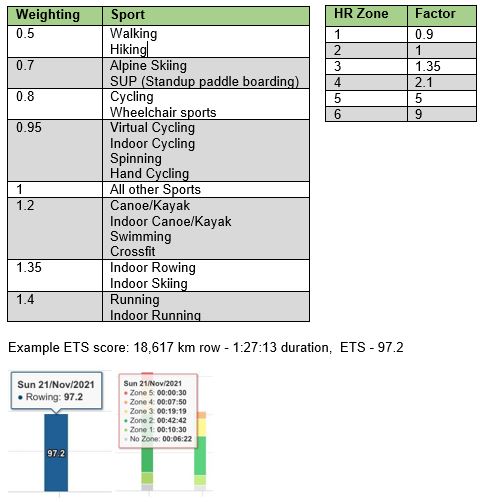Training load is an emerging topic for those serious about training. We have come to the limits of how much time people can train (and recover), now we need to better understand the load that athletes are under.
Once athletes and coaches are better able to quantify the load they are under we will be in a position to manipulate the training programmes and optimise each session, based on these new insights.
Developing a training load calculation is the process of monitoring and quantifying the relative load of each training session in order to understand and determine the optimal amount of training required for and undertaken by each athlete.
The Ludum app-based sports coaching and athlete monitoring software products are helping coaches and athletes alike to define, monitor, and understand training loads. At Ludum we have support for a number of different training load scores including TRIMP, Foster and RPE that all rely on different inputs and calculations but our preferred score is called Endurance Training Score (ETS).
In today’s endurance sport world, understanding training loads and optimising training programmes for each athlete is increasingly based around rapid access to data and improved data analytics. As a result, an enduring focus for Ludum in recent months has been to improve automation in importing data into Ludum’s coaching and performance analysis software products. Now, data from training sessions conducted using GarminConnect, Polar Flow, and Suunto will automatically appear in Ludum.
If you train with a heart rate monitor, with or without using GPS, improved automation in data importing will be relevant to you. Many different apps also provide training scores. However, in Ludum there are three reasons why every rower needs this.
What is Training Load in Rowing?
Training load scores attempt to calculate the physiological impact that a training program has on an athlete by assigning each session a score based on factors that can include duration, intensity, heart rate data, perceived exertion and more.
Coaches and sports scientists use training load scores to understand the stress that athletes are under as a result of the training that they’re prescribing and by tracking that load over time they are able to make interventions and adjust future training in order to maximise the performance of their athletes as well as avoid illness and injury when they become overloaded.
It’s important to remember that managing training load is as much an art as it is a science. Measuring the external load produced by an athlete is relatively easy – how many kg did they lift? How many watts did they produce? We can do this with quite some accuracy, but measuring the internal load is an attempt to understand the physiological cost of the training and to do this we’re making an estimate based on the information that’s available and the scores should be treated as such. Training load scores are just one of many factors that can be taken into account when managing your athlete’s training.
Better information
Ludum is the only platform in the world to offer a truly relevant training load score for rowing. The Ludum rowing training load score is called the Endurance Training Score (ETS). The ETS was devised by the Rowing Science Lead at Australian Rowing and Ludum team member Dr Tony Rice, based at the Australian Institute of Sport in Canberra. Ludum has been working with Dr Rice to implement his T2min score into its platform.
The Endurance Training Score gives the fullest picture of the training load that an athlete is under by taking into account duration and intensity as well as the mode of exercise that the athlete is doing. This way you can be confident comparing a 40 minute bike with a 60 minute row, or a 20 minute swim with a 90 minute run simply by comparing the ETS calculated by our platform. Your ETS will be generated automatically when your heart rate data is imported into the platform.
Here are some examples of factors for different HR zones and weighting for different sports:

Training load over time
With a scientifically validated training score now available for each session, it is possible to determine the training load profile for each athlete over time. This in turn enables objective assessment of how hard an athlete has been training.
Previously, robust measures for monitoring and determining training load for rowers have been difficult to develop. Rowing is a power endurance sport, and rowers tend to use several different power endurance sports for their training. The use of extended intervals in training programmes means that training load or training stress scores can be too linear and may underestimate the actual load on the athletes.
Up until now, the ETS score has been produced manually. Today, with the ability for data to be imported automatically, Ludum has made Dr Rice’s important body of work accessible to all for the first time.
Ludum is continuing to learn a lot about the validity of this new process, and will continue to adjust the set up as required. Feedback from users would be most welcome, as Ludum seeks to make the ETS more accurate to help athletes train better. To assist this effort to improve validation, it is crucial for Ludum to know what training type was done. Many wearable athletic monitoring devices do not make it possible to select the correct training types. Consequently, the Ludum platform now includes a step to enable the athlete to assign the correct session type.
Ease of use
Athletes are used to their data being imported automatically from their wearables. Now, with Ludum, an athlete can import this data to the same place where all the athlete’s rowing-related data is stored. This includes ergometer rowing machine and weight sessions, and all other rowing training sessions.
You can start using the automated imports and the training load scores in Ludum today.
Once you start to appreciate the ebb and flow of the training load your athletes are under you’ll be empowered as a coach to make better decisions for the performance and wellbeing of your team.
View more content like this

Rowing Australia using Ludum to Prepare for World Championships
Rowing Australia have been using Ludum to better track the training of all their athletes. Having used several other well know platforms in the past
Why do you Need an Indoor Rowing Training App?
Following on from the post I did last week about indoor rowing workouts, one of the of the things I find particularly exciting about working
Improving Sports Performance by Measuring Power, not Speed
The ultimate measure of performance is usually time. How long does it take to complete a race. Often coaches and athletes use time to measure


